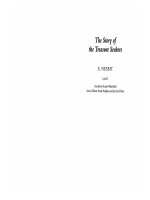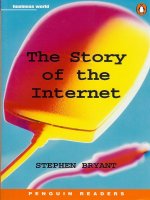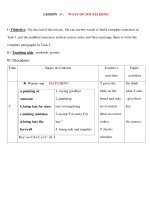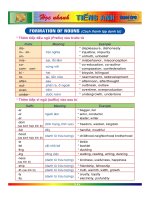DK readers level 3 story of chocolate
Bạn đang xem bản rút gọn của tài liệu. Xem và tải ngay bản đầy đủ của tài liệu tại đây (4.21 MB, 49 trang )
A Note to Parents and Teachers
DK READERS is a compelling reading programme for
children, designed in conjunction with leading literacy
experts, including Cliff Moon M.Ed., Honorary Fellow
of the University of Reading. Cliff Moon has spent many years
as a teacher and teacher educator specializing in reading
and has written more than 140 books for children and
teachers. He reviews regularly for teachers’ journals.
Beautiful illustrations and superb full-colour photographs
combine with engaging, easy-to-read stories to offer
a fresh approach to each subject in the series. Each
DK READER is guaranteed to capture a child’s
interest while developing his or her reading skills,
general knowledge, and love of reading.
The five levels of DK READERS are aimed at
different reading abilities, enabling you to choose
the books that are exactly right for your child:
Pre-level 1: Learning to read
Level 1: Beginning to read
Level 2: Beginning to read alone
Level 3: Reading alone
Level 4: Proficient readers
The “normal” age at which a child
begins to read can be anywhere from
three to eight years old, so these levels
are only a general guideline.
No matter which level you
select, you can be sure that you
are helping your child learn to
read, then read to learn!
Chocolate trees
Do you like chocolate? Most people
would answer “Yes!” We eat an average
of 9 kilograms (20 lbs) of chocolate
per person per year. That’s about
180 chocolate bars each! But where
does chocolate come from, and how
is it made into the sweet, delicious
treats that we love to eat?
The story of chocolate begins in
the rainforest, where cacao (ka-KOW)
trees grow. Pods grow on the cacao trees
and inside the pods are seeds called
cocoa (KO-ko) beans.
These cocoa beans
are the magic
ingredient
in chocolate.
Dried
cocoa beans
Theobroma cacao
In 1753, the Swedish scientist
Linnaeus gave the cacao tree its
scientific name, Theobroma cacao,
meaning “food of the gods”. It was
well known that he liked chocolate!
5
Cacao trees grow in
the hot, damp shade
under the leafy canopy
of the tallest trees in
the rainforest. There,
the cacao trees blossom
with pink and white
flowers. These flowers
grow straight from
the trunk and main
branches. Tiny insects
called midges carry
pollen between the
blossoms, fertilising them
so cocoa pods will grow.
6
A midge sitting on
the tip of a pin.
Only a few
of the hundreds
of blossoms
develop into
cocoa pods.
Like the blossoms, the
pods grow straight from
the trunk and branches
of the tree. Many cacao
trees grow both blossoms
and pods all year round.
7
In about four
months, the cocoa
pods grow to the size
of melons. It takes
another month
before they are fully
ripe. The colour of
the ripe pods ranges
from yellow to dark
red. The pods are hard and must
be split open to show the beans.
Each pod contains about 40 cocoa
beans surrounded by sticky white pulp.
These are the precious beans that
make chocolate.
Who first discovered that these
strange-looking beans, from these
strange-looking trees, could be used
to make such a delicious treat?
8
9
An ancient treat
Cacao trees grow in
the ancient area called
Mesoamerica, which
includes southern Mexico
and Central America.
Many experts believe that the first
people to crack open a cocoa pod and
use the bean were the ancient Olmecs,
who lived from about 1200 to 200 BCE.
North
America
Aztec
territory
Olmec
territory
Mayan
territory
10
The three
civilisations were
in Mesoamerica.
South
America
The Mayans were the first people
to plant the beans of wild cacao trees.
This was the beginning of cocoa
farming. In return for other goods,
the Mayans
traded cocoa
beans to the
Aztecs, whose
lands were too
dry to grow
cacao trees.
Olmec monuments
Much of Mesoamerican culture
is said to originate from the
ancient Olmecs. In southern
Mexico, they carved huge stone
heads to praise their rulers.
11
Both the Mayans and Aztecs
used cocoa beans to make a drink
known as chocolatl. The beans
were dried and crushed, and then
mixed with water. The Mayans
drank chocolatl hot, whilst the
Aztecs drank it cold.
12
Chilli
peppers
Often flavourings, such as
chilli or vanilla, were added.
Nevertheless, the taste must
have been very bitter.
In fact, the word chocolatl is
said to mean “bitter water”.
Vanilla
pods
Chocolatl was
served on special
occasions, such as
rituals and royal
feasts. The mixture
was usually poured
from a height into
the drinking vessel
to make a thick
foam on the top.
13
Both the Mayans and
Aztecs used cocoa beans as
money. They also gave beans
as special gifts, and as offerings
to the gods.
The land where
cacao trees grew
became very valuable.
Over several centuries,
the Aztecs spread and
took over much
of this land.
14
They collected taxes from
the people in the form of
cocoa beans. Their Aztec
kings filled storehouses
with the precious
beans. People say
that the emperor
Montezuma had
more than
960 million beans
in his storehouses.
Emperor
Montezuma
Army food supplies
Some of Montezuma’s
cocoa beans were made
into wafers for his army.
This was an early type
of instant cocoa mix.
15
To Europe and beyond
In 1492, Christopher Columbus
became the first European to sail to
the Americas. During his fourth and
final voyage to the New World in 1502,
his ship came across a Mayan trading
canoe full of cargo. Columbus ordered
his crew to capture it.
16
Columbus’s son, Ferdinand, wrote that
among the loot taken from the canoe
were “almonds”. Ferdinand noticed that
the Mayans treated them with great care.
These “almonds” were, of course, cocoa
beans. Although Columbus took some
back to Spain, both he and the Spanish
king were far too interested in gold
and other treasures to take much
notice of the small brown beans.
17
Other explorers soon
followed Columbus to
the New World. In 1519,
the Spanish explorer
Hernando Cortés arrived
in Mexico. The Aztec
emperor, Montezuma,
served him a feast with
chocolatl to drink.
18
But Cortés had come to Mexico to
claim the land for Spain, and by 1521
he had conquered the great Aztec
nation. The Spanish explorers took
on some Aztec customs, such as using
cocoa beans as money. The taste of
chocolatl was too bitter for them
at first, but by adding sugar
to sweeten it, the exotic
drink became
a favourite treat.
Sugar cane
Molinillo (mole-i-NEE-yo)
The Spanish explorers used
a mixing stick called a molinillo
to whip up the thick foam
on top of their
hot chocolatl.
19
The explorers brought cocoa beans
back to Spain and introduced the hot,
sweet drink to their country.
The chocolate drink soon became
popular with rich families. Both cocoa
beans and sugar had to be imported
from the tropical rainforests in
Central America, so chocolate was
a luxury that only the rich could afford.
People also thought that chocolate
was good for their health.
Explorers from Spain
were already busy in
the New World, taking
over land that was suitable
for growing cacao trees.
They could see that cocoa
was going to be a moneymaking crop.
20
21
As there were few
cocoa beans, the Spanish
did not want to share
the delights of drinking
chocolate with other
countries. It took nearly
100 years for the
secret to spread to
other parts of Europe.
There is a legend
that English pirates
captured a Spanish
ship carrying cocoa
beans. The pirates
thought that the
beans were sheep
droppings and
they burned
them!
22
However, by the
1650s, Europeans
were drinking
chocolate at
fashionable cafés
called chocolate
houses. In 1660,
Princess Maria
Teresa of Spain married King Louis XIV
of France. Maria Teresa liked chocolate
so much that she had a special maid to
make it for her. Soon, the rich French
families began copying their new queen
and liked the taste, too.
Chocolate pot
Tea from Asia and coffee from
Africa were also popular in
Europe at this time. Special jugs,
such as this chocolate pot, were
used to serve each drink.
23
Cocoa powder
By the 1700s, European
settlers took the chocolate
drink back across the
Atlantic Ocean, where
it became a popular treat
in North America.
In 1765, the first American
chocolate factory opened in
Massachussetts, USA.
24
John Hannon had run a chocolate
business in Ireland. While looking for
work after arriving in America, he
met Dr. James Baker, who
suggested that they go
into business together.
Their new chocolate
factory had
a waterwheel
that powered
a machine,
which ground
the cocoa
beans into a
fine powder.
Until then,
most cocoa
powder had
been handmade.
25
Chocolate factories
In 1765, the Scottish inventor
James Watt built a steam engine
that made goods quickly and cheaply.
Using a steam-powered chocolate
grinder made chocolate a cheaper
treat for everyone.
James Watt
studying a
steam engine
26









